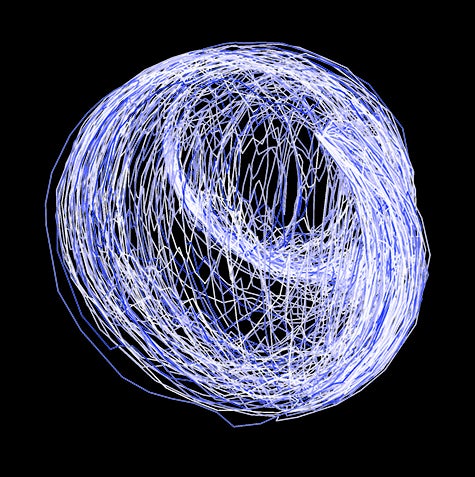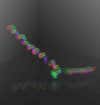A Lost Locust, Refound
50 years after it was found in the Dominican Republic, well-preserved amber is finally re-emerging from the vaults of the Illinois Natural History Survey. Inside the amber lies a unique array of impeccably-preserved insects that have given researchers new insights into how insects have evolved. In the amber, they discovered a new species of pygmy locust that lived between 18 to 20 million years ago. The locust had vestigial (non-functional) wings, which was a transitional phase between the winged locusts of the past and today’s non-winged varieties.
A Sexy Glow
Did you know that parrots are one of the few animals with flourescent feathers? Well, you can’t see it with the naked eye, but they know it’s there. These budgerigar parrots, illuminated here with UV light (like that sweet blacklight you would use at college parties), use their appealing plumage as a sexual signal; according to a recent study, females may prefer males with brighter plumage.
The Cheesy Microbiome
Sometimes the radiating aroma of a delicious stinky cheese serves as a good reminder for the gluttonous microbes and fungi that lie within. But even though humans have been making cheese for centuries, scientists didn’t know much about the unique makeup of microbes in different varieties of cheese. In a recent study, researchers found some surprises, like marine-based bacteria living in cheeses made far from the coast. This image is a closeup of robiola, an Italian cheese, with its resident fuzzy mold (left) and Proteobacteria (dots on right).
Wild Star-Forming Disks
Planets in a solar system all tend to orbit around the same plane. But for exoplanets outside, orbits are far less predictable; they can behave irregularly or have odd shapes or alignments. But researchers at the Atacama Large Millimeter/submillimeter Array (ALMA) telescope in Chile have gotten their first clear glimpse of two young stars with gas clouds that are in very different alignments, despite being a binary system. As the stars in HK Tauri cool, their gas clouds will clump together to form planets, which may be pulled in different directions thanks to the competing gravitational pulls of the misaligned stars. This image is an artist’s rendering of ALMA’s discovery.
Birds’ Flights Match Quantum Predictions
More quantum news this week takes a surprising shape: the movements of starling flocks, for example. Italian physicists recently noted that the movement of starling flocks mirrors the quantum dynamics of superfluid helium. For both the birds and helium, the point when they change direction is a moment of weakness; the flock isn’t flying as cohesively as it could, so that’s when predators like peregrine falcons have their best opportunity to attack.
Do The (Bacteria) Wiggle
Remember learning about that funny little appendage on a cell called a flagellum? It’s kind of like a tail or an arm that the cell uses to propel itself and get around. Using sophisticated imaging techniques, researchers recently found that the flagellum is not the only way a bacterium can move — its body motion helps to propel it, too. When bacterium moves its body in a helix movement, as is shown here, the movement propels it forward.
A Zoo For The Future
After the Copenhagen zoo executed a giraffe earlier this year, Danish zoos don’t have a great international reputation. But that might be about to change; Danish architects BIG (Bjarke Ingels Group) just revealed new plans for a zoo that is less confining for animals and for their human observers. The buildings in the remodeled park in Givskud, Denmark, would be integrated into the landscape to be less disruptive. Humans could inhabit the large central square while animals move freely outside of it. The project is expected to be completed in 2019.
The Future Mars Rover
This week, NASA unveiled plans for its new Mars rover, set to launch in 2020. Although it has a lot in common with its older silbling, the Curiosity rover, some of its gadgets give this rover a slightly different purpose. It will be able to determine a rock’s composition with a laser and x-ray, use radar to detect what’s beneath the surface, and drill into the ground on a quest to find microbes. Even more interesting is one gaget called MOXIE that will pave the way for an eventual manned mission to Mars by using electricity to create oxygen from carbon dioxide. Read more of PopSci’s coverage of the 2020 Mars Rover
All Of Humanity’s Culture In A Five Minute Video
Instead of focusing on events as historians typically do, researchers from the University of Texas at Dallas wanted to give other historians the tools to find correlations between these events and larger migratory shifts. Using the Google database Freebase, the researchers found the dates and locations for the births and deaths of 120,000 notable people over the course of history. The result is a captivating overview of the world’s cultural landscape. Watch the whole video here.









